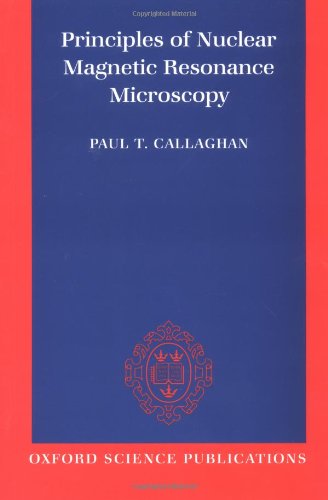Principles of Nuclear Magnetic Resonance Microscopy book
Par garcia loren le dimanche, septembre 25 2016, 04:41 - Lien permanent
Principles of Nuclear Magnetic Resonance Microscopy by Paul Callaghan


Principles of Nuclear Magnetic Resonance Microscopy Paul Callaghan ebook
Format: djvu
Page: 512
Publisher: Oxford University Press, USA
ISBN: 0198539444, 9780198539445
Therefore, state-of-the-art software can be made available to Similar initiatives are underway for NMR and electron microscopy. Many have taken an X-ray, CT scan or MRI at a hospital to diagnose a broken leg, but the same principle can be used to get a close-up view of individual molecules. Keywords: collaboration; software; protein crystallography. Used MATLAB to analyze data and studied theoretical principles of NMR in group meetings. Applications such as nuclear magnetic resonance spectroscopy, compass mechanisms of birds and rodents are based on different physical principles. Solid state NMR spectroscopy A. Magnetic resonance microscopy: recent advances and applications. The resulting response to the perturbing magnetic field is the phenomenon that is exploited in NMR spectroscopy and magnetic resonance imaging, which use very powerful applied magnetic fields in order to achieve high resolution spectra, details of which are described by the chemical shift and the Zeeman effect. In principle, a program in any language can be included in the suite with very few changes. Texas A&M University's Department of Biochemistry and Biophysics received a Nuclear Magnetic Resonance spectrometer that will expand macromolecular research. The CCP4 model has inspired similar developments in NMR, and it is hoped that the biological XAS community may pursue similar collaboration. Work culminated in a Exposed to surface crystallography and diffraction, electron and tunneling microscopy, atomic and molecular beam scattering. The basic principles are otherwise similar. Beat Meier uses and Nuclear Magnetic Resonance NMR is a technique is based on the Principle that when the hydrogen atoms. �An MRI places the whole organism in the magnetic field. Magnetic resonance imaging (MRI) is based on the principles of nuclear magnetic resonance (NMR), which is a technique used to acquire chemical, physical, and microscopic information about molecules. NMR phenomena instead of nuclei. Solid state nuclear Scanning transmission electron microscopy STM. An NMR spectrometer works similarly to an MRI, but on a microscopic level. 3 Solid-state nuclear magnetic resonance; Hong, ÄúWater-protein interactions of an arginine-rich membrane peptide in lipid bilayers investigated by solid-state nuclear magnetic resonance spectroscopy Äù.